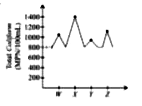Four samples of water [H2O] are collected from different sources, Each sample on analysis was found to containsame percentage of oxygen. Which law of chemical combination is demonstrated by the above observation?
The law of constant combination is demonstrated by this observation.
Topper's Solved these Questions
- BOOK - DINESH PUBLICATIONCHAPTER - ATOMS AND MOLECULESEXERCISE - SHORT ANSWER42videos
ATOMS AND MOLECULES
- BOOK - DINESH PUBLICATIONCHAPTER - ATOMS AND MOLECULESEXERCISE - LONG ANSWER16videos
ATOMS AND MOLECULES
- BOOK - DINESH PUBLICATIONCHAPTER - ATOMS AND MOLECULESEXERCISE - N.C.E.R.T. END EXERCISE11videos
ATOMS AND MOLECULES
- BOOK - DINESH PUBLICATIONCHAPTER - IS MATTER AROUND US PUREEXERCISE - LAQs10videos
IS MATTER AROUND US PURE
Similar Questions
(a) Four samples of carbon dioxide (CO2) were prepared by using different methods. Each sample on analysis was found to contain 27.27% carbon by mass. Name the law which is in agreement with this observation.
(b) Explain why the number of atoms in one mole of hydrogen gas is double the number of atoms in one mole of helium gas.View SolutionAn element forms two oxides of 2.900g and 2.250g of these oxides each of found to contain 1.12L of O2 at STP. Which law of chemical combination is illustrated by these data?
View Solution
Knowledge Check
- Question 1 - Select One
If water sample are taken from sea, rivers or lake, they will be found to contain hydrogen and oxygen in the approximate ratio of 1:8. This indicates the law of :
AMultiple proportionBConstant PorportionsCReciprocal ProportionsDConservation of mass - Question 2 - Select One
Assertion : Pure water obtained from different sources such as river, well, spring, sea etc. always contains hydrogen and oxygen combined in the ratio 1:8 by mass.
Reason : A chemical compound always contains elements combined together in same proportion by mass, it was discovered by French chemist, Joseph Proust (1799).AIf both assertion and reason are true and the reason is the correct explanation of the assertion.BIf both assertion and reason are true but reason is not the correct explanation of the assertion.CIf assertion is true but reason is false.DIf the assertion and reason both are false. - Question 3 - Select One
Irrespective of the source, pure sample of water always yeilds 88.89% mass of oxygen and 11.11% mass of hydrogen. This is explained by the law of
Aconservation of massBconstant compositionCmultiple proportionsDconstant volume
A student collected three samples of water from different sources and found out the percentage of hydrogen and oxygen by mass in thse samples. It should have been 1 : 8 by mass. But it was different in all three samples, Moreover, the values did not match
(i) In your opinion why did the student get different results for different samples ?
(ii) What should have been done by him ?
(iii) Which law of chemical combination is supported by these observations
(iv) How will you check the purity of water in the laboratory ?View SolutionIf 100 grams of pure water taken from different sources is decomposed by passing electricity, 11 grams of hydrogen and 89 grams of oxygen are always obtained' . Which chemical law is illustrated by this statement ?
View SolutionIn a study, water samples of Yamuna river were collected from four different cities (W, X, Y and Z) to check the presence of Coliform bacteria. The result obtained was plotted in the given graph.
Select the incorrect statement regarding this.
 View Solution
View SolutionIrrespective of the source, pure sample of water always yeilds 88.89% mass of oxygen and 11.11% mass of hyrdogen . This is explained by the law of:
View SolutionIrrespective of the source, pure sample of water always yields 88.89% mass of oxygen and 11.11% mass of hydrogen. This is explained by the law of
View Solution

